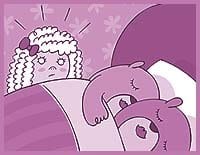For someone who has known, loved and fucked lesbian bears finding evidence of them in Toronto was a surprisingly difficult challenge. Perhaps the delay in the end of winter means they are all still hibernating.
Gay male bears are well-documented. But some men I know were surprised to hear about the existence of lesbian bears – or ursulas, as I like to call them.
The word ursula is a feminization of the word ursine meaning “of or pertaining to a bear, resembling a bear,” and was the name of a lesbian bear and bear-lovers e-mail group I used to subscribe to.
Most lesbian bears are butch, fat or stockily built and sometimes taller than average. Like their gay male counterparts who tend to be hairy, female bears often resist shaving their legs and underarms, while coveting any facial hair that appears. Ursulas are down-to-earth and are usually found in jeans or leather.
I didn’t think Ursulas were rare, but I’ve turned up neither hide nor hair of them in Toronto in my recent quest. I did however, find lots of them across the US, and as far away as Australia.
I don’t know why they aren’t popular locally. Perhaps, as a friend suggested, we’re still a little bit of a backwater here and don’t popularize cultural identities as readily as our American neighbours. On the other hand, individuality can be an asset.
Labelling within the lesbian community is common and yet often rejected. In Toronto and around the world there exists a wide list of lesbian identities ranging from the most common butch-femme dynamic to lesbian subcultures such as the granola dykes, lipstick lesbians, amazons, leather dykes and the anti-penetration lesbian separatists.
For many women I talked with their bear identity is linked to another part of their lesbian identity.
“I first started figuring out my bear identity in terms of the gay men’s bear community,” says Rob Sweeney of Santa Cruz, California. She identifies as a grrrl bear. “So being a bear is also about being a big ol’ pervert who likes to roll around and play raunchy bear games.”
Sharon Jill “Bear” Bergman, of Northampton Massachusetts, says that being a bear is about “not being afraid to be bigger, both physically and in terms of the space I take. There’s a lot to be said for having or being a sexual partner that no one is afraid to crush or break – I get to wrestle and roll around and play a lot.”
The stereotypical gay male bear is usually large, with a full beard and a belly. Being an ursula goes beyond physical to the attitude she projects and the way she moves in the world, but physicality is the most recognizable feature.
Most of the bears I talked to agree that the physical aspects are critical, but recognize other components as well.
“Being a bear means being big and cuddly,” says Sweeney, “and big and growly. Being a bear means being comfy in jeans and my boots, and being comfy with my big bear body.”
Marty Hoy of Portland, Oregon says she fits the type.
“I am stockily built, butch and cuddly. When I meet the gay male bears, I usually click with them, and they seem to spot me as another bear. I have the usual bear traits: easygoing, sincere, down-to-earth, comfortably dressed, expressing a sort of earthy masculinity, sort of a secure, quiet sense of power, etc. I think that the bear image is a great image for big women, and there aren’t that many good images in the culture out there, so we just kind of have to figure out our own.”
I called an ex-girlfriend, Donna Fortney, who identities as a bear, to get her perspective. She lives in Middletown, Pennsylvania. For her, being a bear is linked to her identities as a fat, butch, leather dyke. I must say I regret never using her bear identity as an excuse to dress up as Goldilocks and play “who’s been sleeping in my bed.”
Fortney feels that her mother was also a bear and that influence rubbed off.
“My family was very much a matriarchy. My mother would put out an attitude that said, ‘Go ahead and fuck with me but don’t fuck with my family or my children,’ and people didn’t.”
Perhaps my attraction to dyke bears is in part the sense of relation I have to the spiritual aspect of a bear. Both Hoy and Sweeney identify the bear as their totem animal. According to Animaltotem.com, “Bear teaches us to respect our natural hibernation cycles. Just as bear rests during winter and reawakens during spring, we need spaces of rest and rejuvenation. Bear calls us to awaken the potential within ourselves and the power of our unconscious mind. Bear reminds us there is a time for playfulness and a time to be assertive.”
“It’s also partly a magical identity for me,” says Sweeney. “If I have any sort of totem animal, it’s bear. I hibernate. I thrive on salmon. I like my den just my way. I can be very cute and fun, but mess with me or simply get between me and the (metaphorical and literal) berries, and I’ll rip you open damned fast.”
Sweeney regrets that there aren’t more organized communities for lesbians.
“The guys have gatherings and play parties and magazines and all sorts of things, and we don’t. I sometimes feel like a bear subculture for women is still in its infancy – or rather cubhood.
“The way the gay male bear community has organized itself, and made a value on experience and size and a dirty mind, makes me sad that there’s not more of that for the women’s community.

 Why you can trust Xtra
Why you can trust Xtra


